

Une année scolaire au collège Édouard Branly de Grand Quevilly. 1.1- La croissance démographique et ses effets - Histoire & Géographie 5e (programme 2016) 5e Sommaire – HISTOgraphie. Khartis - cartographie thématique. Le contenu de ce site internet est fourni par : Sciences Po 27 rue Saint-Guillaume 75337 Paris Cedex 07 Tel. : 01 45 49 50 50 Fax. : 01 42 22 31 26 webmestre@sciencespo.fr.
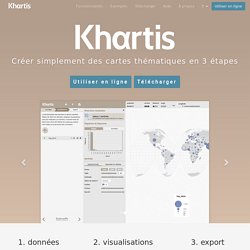
Timeline. 20 infographies méthodologiques et pratiques pour apprendre avec le numérique. En 2014, nous avons déjà évoqué les travaux de Thierry Karsenti , enseignant-chercheur (Université de Montréal) spécialiste de l’intégration pédagogique du numérique dans les pratiques éducatives, avec cet article publié : Apprendre avec le numérique : 12 infographies méthodologiques et pratiques.
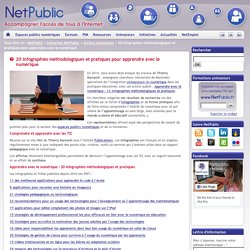
Ce chercheur vulgarise ses résultats de recherche via des affiches sur la forme d’infographies et de fiches pratiques afin de faire mieux comprendre l’intérêt du numérique pour ce qui relève de l’apprentissage au sens large, bien entendu pour le monde scolaire et éducatif (universités…). Ces représentations offrent aussi des perspectives de conseil de premier plan pour le secteur des espaces publics numériques et de la formation. Comprendre et apprendre avec les TIC Ces affiches librement téléchargeables permettent de découvrir l’apprentissage avec les TIC avec un regard renouvelé et un effort de synthèse. Breakout EDU Games. Breakout. Cours d'Histoire-Géographie de Florian NICOLAS. Cube Creator.
Summarizing information is an important postreading and prewriting activity that helps students synthesize what they have learned.
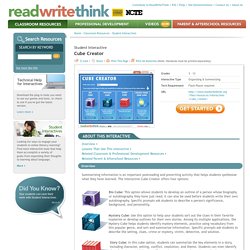
The interactive Cube Creator offers four options: Bio Cube: This option allows students to develop an outline of a person whose biography or autobiography they have just read; it can also be used before students write their own autobiography. Specific prompts ask students to describe a person's significance, background, and personality. Mystery Cube: Use this option to help your students sort out the clues in their favorite mysteries or develop outlines for their own stories. Among its multiple applications, the Mystery Cube helps students identify mystery elements, practice using vocabulary from this popular genre, and sort and summarize information.
Story Cube: In this cube option, students can summarize the key elements in a story, including character, setting, conflict, resolution, and theme. Librarian Approved: 30 Ed-Tech Apps to Inspire Creativity and Creation. Tool discovery is often a challenge for teachers interested in finding ways to use technology that will change the way they and their students work.
With so much going on in the classroom, many teachers don’t have the time to test out various apps and find the perfect tool to meet their needs. Luckily, several tech-savvy librarians have been curating the apps their colleagues find useful and sharing the all-stars with one another through personal learning communities (PLC) and edWeb webinars. These educators are paying attention to their own working habits, as well as those of students, to figure out which technology products and trends are here to stay. Michelle Luhtala, a school librarian in New Canaan, Connecticut, has noticed that much of her own work has transitioned from the computer to her smartphone.
She sees the same trend in students, but also recognizes many schools have policies against phones because they can be distractions. Check out previous years favorites here and here. XIA. Classes inversées : enseigner et ... Salman Khan: Let's use video to reinvent education. Clic2015.pdf. Modifying the Flipped Classroom: The "In-Class" Version. So.

You've tried flipping your class, and it didn't go well. Or you've heard about flipping and want to try the approach, but you're pretty sure it won't work in your school. Don't give up yet -- with a slight twist, flipping might be possible for you after all. Flipped classrooms -- where direct instruction happens via video at home, and "homework" takes place in class -- are all the rage right now, and for good reason. Early research on flipped learning looks promising. But successful flipping has one big catch -- if it's going to work, the at-home learning absolutely must happen. Apps That Rise to the Top: Tested and Approved By Teachers. Michelle Luhtala/Edshelf With the thousands of educational apps vying for the attention of busy teachers, it can be hard to sift for the gold.
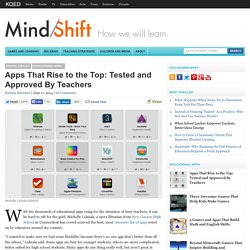
Michelle Luhtala, a savvy librarian from New Canaan High School in Connecticut has crowd-sourced the best, most extensive list of apps voted on by educators around the country. “I wanted to make sure we had some flexibility because there’s no one app that’s better than all the others,” Luhtala said. Embracing Flipped Learning Tour Webinar with Jon Bergmann and Aaron Sams - ASCD. The Tools to Flip Your Classroom Collection by Jake Duncan.
Edshelf Tools to Flip Your Classroom Curated by Jake Duncan Share: 19 followers 31 tools View as.

8 Crucial Resources For Flipped Classrooms. YouTube This might be the most popular tool teachers have used for flipped instruction.
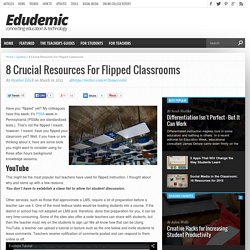
I thought about why and came up with a few reasons. You don’t have to establish a class list to allow for student discussion. Other services, such as those that approximate a LMS, require a lot of preparation before a teacher can use it. One of the most tedious tasks would be loading students into a course. Create your own whiteboard videos. Powtoon. Camtasia Reviews. Edshelf Page not found.

If you think this is a mistake let us know. Were you looking for a tool? Try a search: Sign in Sign in using one of these services. Ma classe inversée. Classe Inversée - Libérons l'éducation. Qu'est-ce que la classe inversée ?LeWebPédagogique. Social Development Theory (Vygotsky) Summary: Social Development Theory argues that social interaction precedes development; consciousness and cognition are the end product of socialization and social behavior.
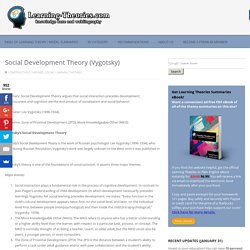
Originator: Lev Vygotsky (1896-1934). Key terms: Zone of Proximal Development (ZPD), More Knowledgeable Other (MKO) Vygotsky’s Social Development Theory Vygotsky’s Social Development Theory is the work of Russian psychologist Lev Vygotsky (1896-1934), who lived during Russian Revolution. Vygotsky’s work was largely unkown to the West until it was published in 1962. How the Flipped Classroom works.
La classe inversée. Pédagogie Inversée. 9 Video Tips for a Better Flipped Classroom. Flipped Classroom | November 2013 Digital Edition 9 Video Tips for a Better Flipped Classroom Early adopters share how schools can find success with teachers and students alike--even when the technology seems as topsy-turvy as the lessons.
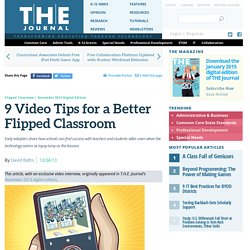
Quand des professeurs d’Histoire-Géographie renversent leur classe 1/2. Meirieu : Du bon usage des « innovations » Online Education as an Agent of Transformation. CCDMD. The Teacher's Guide To Flipped Classrooms. Since Jonathan Bergman and Aaron Sams first experimented with the idea in their Colorado classrooms in 2004, flipped learning has exploded onto the larger educational scene. It’s been one of the hottest topics in education for several years running and doesn’t seem to be losing steam. Basically, it all started when Bergman and Sams first came across a technology that makes it easy to record videos. They had a lot of students that regularly missed class and saw an opportunity to make sure that missing class didn’t mean missing out on the lessons.
Once students had the option of reviewing the lessons at home, the teachers quickly realized the shift opened up additional time in class for more productive, interactive activities than the lectures they’d been giving. And voila: a movement began. Compte rendu d’une stratégie de classe inversée en collège (1) Flipped Classroom Visually Explained for Teachers. Overview and history of algebra. 5 Things I Wish I Knew When I Flipped My Class.mp4. The Flipped Class: Myths vs. Reality. Editor's Note: On the heels of our viral posts in over 100 countries about the flipped classroom earlier this year (links below), we asked Jon Bergmann if he could share some of the feedback he was receiving in light of the notable interest about this topic. The timing couldn't have been more perfect since he was about to leave for a conference about you-guessed-it, the flipped class.
Here is Part 1 of our three part series The Daily Riff. See Part 2 and 3 links below. - C.J. UMapper / Home. Flip Learning. Flipped Classroom 2.0: Competency Learning With Videos. The flipped classroom model generated a lot of excitement initially, but more recently some educators — even those who were initial advocates — have expressed disillusionment with the idea of assigning students to watch instructional videos at home and work on problem solving and practice in class. Biggest criticisms: watching videos of lectures wasn’t all that revolutionary, that it perpetuated bad teaching and raised questions about equal access to digital technology.
Now flipped classroom may have reached equilibrium, neither loved nor hated, just another potential tool for teachers — if done well. “You never want to get stuck in a rut and keep doing the same thing over and over,” said Aaron Sams, a former high school chemistry teacher turned consultant who helped pioneer flipped classroom learning in an edWeb webinar. La classe inversée - IClasse 130. Définir des objectifs pédagogiques efficaces et cohérents grâce à la taxonomie de Bloom et la méthode SMART. Une fois les besoins et attentes de formation analysés, définir vos objectifs pédagogiques constitue une étape fondamentale dans le développement de votre projet de formation. La taxonomie de BLOOM. La classification des objectifs en catégories est ce que l'on appelle la « Taxonomie des objectifs ». L'intérêt d’une taxonomie est qu'elle permet d'identifier la nature des capacités sollicitées par un objectif de formation et son degré de complexité.
Cette information, parmi d’autres, permet d’adapter la méthode de formation. De ses travaux Benjamin Bloom , psychologue en éducation, a fait émerger une classification des niveaux de pensée importants dans le processus d'apprentissage. Stage Pedagogie Inversee by Joel Cohen on Prezi. Knowmia - Technology for Teaching. Made Simple. CTE - Active Learning. Research suggests that audience attention in lectures starts to wane every 10-20 minutes.
Incorporating active learning techniques once or twice during a 50-minute class (twice to or thrice for a 75-minute class) will encourage student engagement. Active learning also: Implementing any new teaching technique can be a daunting or challenging task. Some students may not accept new learning activities with complete ease. Rather than trying to engage all students, focus on engaging more students in more meaningful ways. Angelo, T.A. & Cross, K.P. (1993). Bonwell, C. Davis, B.G. (2009). Deslauriers L, Schelew E, Wieman C. (2011). Felder, R.M. & Brent, R. (1996). Felder, R.M. & Brent, R. (2009). CTE - Collaborative Learning. What is collaborative learning? What is the impact of collaborative learning or group work? IClasse 130.